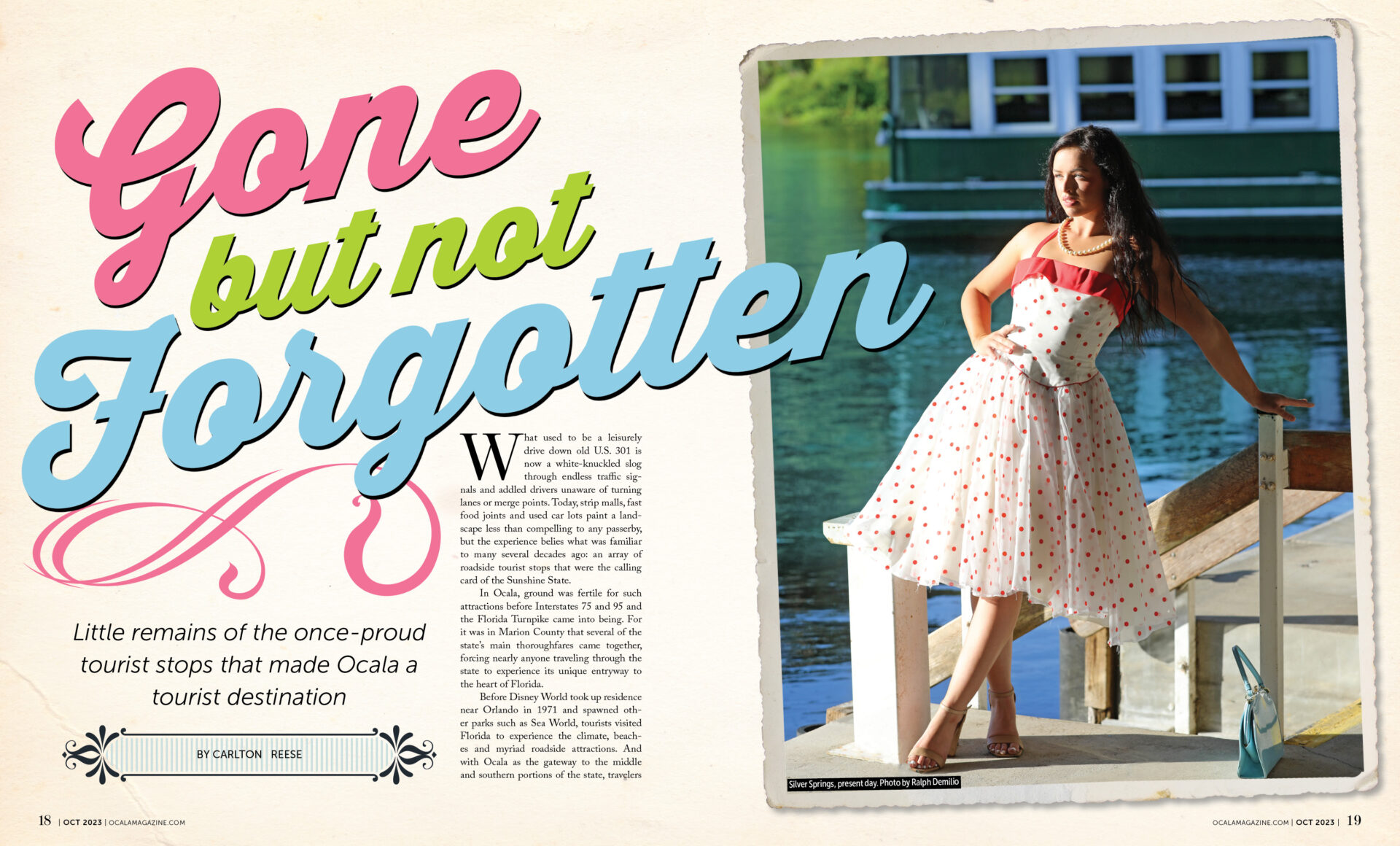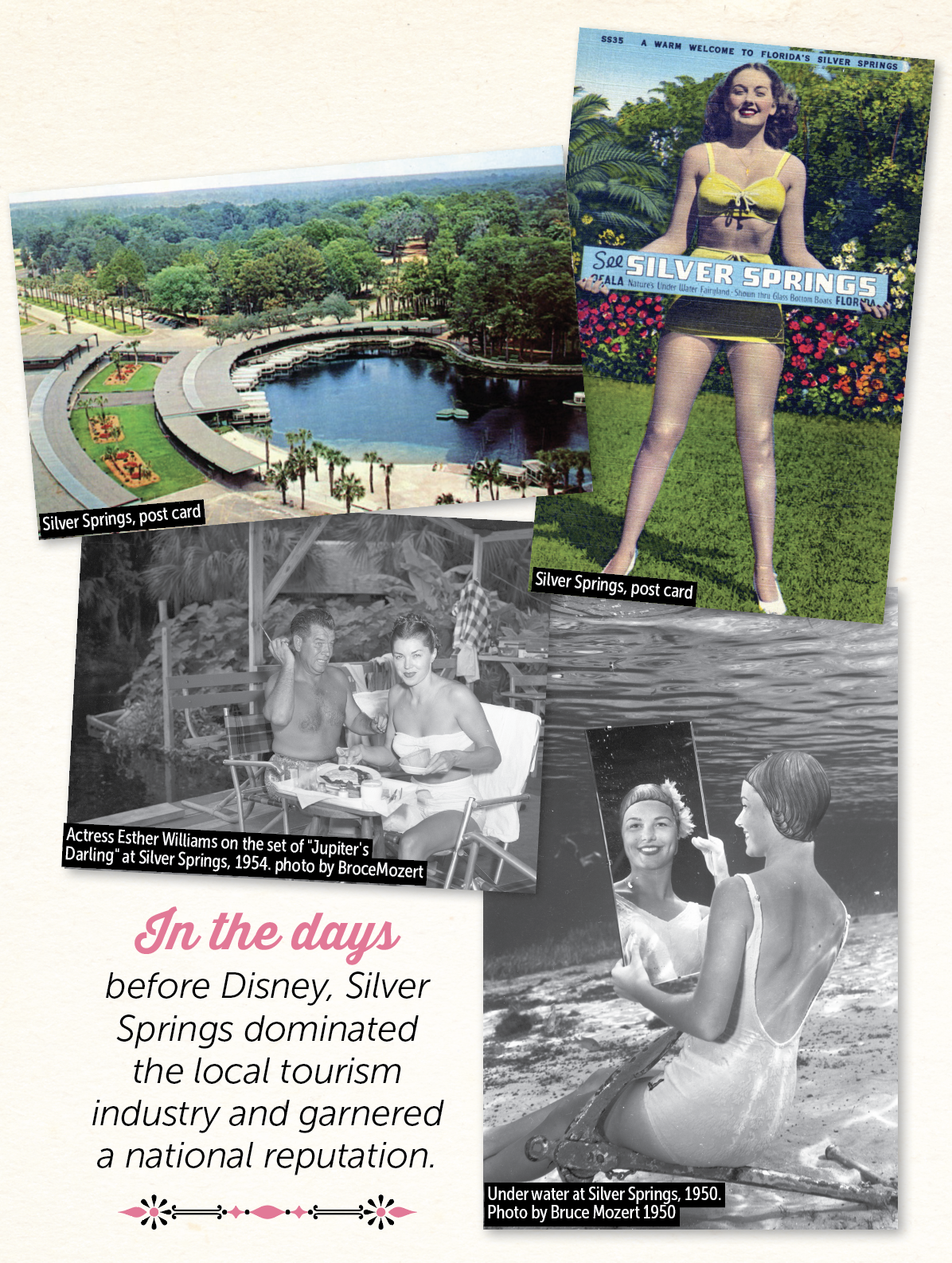Little remains of the once-proud tourist stops that made Ocala a tourist destination

What used to be a leisurely drive down old U.S. 301 is now a white-knuckled slog through endless traffic signals and addled drivers unaware of turning lanes or merge points. Today, strip malls, fast food joints and used car lots paint a landscape less than compelling to any passerby, but the experience belies what was familiar to many several decades ago: an array of roadside tourist stops that were the calling card of the Sunshine State.
In Ocala, ground was fertile for such attractions before Interstates 75 and 95 and the Florida Turnpike came into being. For it was in Marion County that several of the state’s main thoroughfares came together, forcing nearly anyone traveling through the state to experience its unique entryway to the heart of Florida.
Before Disney World took up residence near Orlando in 1971 and spawned other parks such as Sea World, tourists visited Florida to experience the climate, beaches and myriad roadside attractions. And with Ocala as the gateway to the middle and southern portions of the state, travelers were offered many opportunities to spend their leisure time and their money in what was a sleepy Central Florida enclave.
Alas, all but one of these iconic sites has since evaporated with the interstate highways and the unyielding pull of Disney. All that remains in their places are vacant fields, shopping malls and other retail developments.
In the days before Disney, Silver Springs dominated the local tourism industry and garnered a national reputation — a must-stop for tourists traveling through Florida. The park at Silver Springs has gone through quite an evolution since the 1800s, but it was in the 1950s and 1960s when it became more than just a natural phenomenon and became a tourist attraction with few peers. Just as Disney World spawned satellite parks with its success, so too did Silver Springs.
Few people today would even recall the Carriage Cavalcade, a museum of early automobiles, that existed across the street from the entrance to Silver Springs. In the 1960s it became the Early American Museum and the History on Wheels. The original curator was Sidney Strong and in the 1980s the collection was sold to the Silver Springs attraction, which would house the museum on its property.
The building that housed the Carriage Cavalcade still exists several hundred feet to the east of the Silver Springs entrance on State Road 40 and looks remarkably the same, save for its color and dilapidated state. It was last home to American Precision Industries and sits abandoned.
The Silver Springs park itself was in its heyday from the 1940s through the 1970s and was still popular into the late 2000s when it was taken over by the state of Florida. Known as the site of the oldest commercial tourist attraction in Florida, today Silver Springs boasts its natural beauty all the same, but gone are the bear and giraffe exhibits, the children’s carousel and animal shows that were so popular. The Jungle Cruise and Jeep Safari rides no longer exist, but folks can still ride the famous glass bottom boats, hearkening back to the halcyon days of the local tourist stop.
“The glass bottom boats were the most popular thing and there were often long lines to get on them,” remembers Beth Ritterhoff Noble, who worked at the park in the late 1970s. “Some of the boat drivers had been there for decades and knew the river like the back of their hand and were very entertaining — they had a following.”
The river is still there, and the glass bottom boats still patrol the river, but the evolution of Silver Springs continues beyond its era as a tourist attraction. Paddle boards and kayaks have replaced the Jungle Cruise and a walking path takes one where the Jeep Safari used to roam.
Next door, though, nothing exists of the park that sat there: Wild Waters. Not even a ghost town, it’s now a vacant lot without the remnants of even a forgotten nail or two-by-four exists where Wild Waters once stood. A water park, replete with slides, a wave pool, miniature golf course, game rooms and eateries, Wild Waters was built in 1978 and closed for good in 2016.
Noble, who worked at Silver Springs during her high school years, was later a Wild Waters lifeguard during her college years of the early 1980s. The memories are fond and indelible.
“After the park closed (each day), we used to ride the slides,” Noble remembers. “Kind of a ‘all hell breaks loose’ kind of thing — it was a lot of fun. Silver Springs was more of a job; at Wild Waters it was more of a fun time.”
The steel-framed rides could not withstand the Florida humidity as well as the wooden rides and corrosion took its toll over the years. When rumors of its demise hit the people of Ocala, groups organized to sign petitions to save it, to no avail.
“I kind of miss it — I get nostalgic,” Noble said. “Many people had hours and hours of joy there, me being one of them.
“I was a little sad (upon hearing of Wild Waters’ closure). I thought maybe I should get out there and ride the slides again. I think the people of Ocala who had a chance to be out there and have fun left there thinking they got their money’s worth.”
 A little bit to the west of Silver Springs and Wild Waters on SR 40 was perhaps the most iconic of Ocala’s tourist attractions. Though it lasted only 20 years, Six Gun Territory seems to hold a special place in the hearts of locals who were around during its run from 1963 to 1984. Built when western themed television shows and movies were extremely popular, Six Gun Territory capitalized on that wave by recreating an old town from the wild west with gunfights in the street, can-can dancers in saloons and an Indian village.
A little bit to the west of Silver Springs and Wild Waters on SR 40 was perhaps the most iconic of Ocala’s tourist attractions. Though it lasted only 20 years, Six Gun Territory seems to hold a special place in the hearts of locals who were around during its run from 1963 to 1984. Built when western themed television shows and movies were extremely popular, Six Gun Territory capitalized on that wave by recreating an old town from the wild west with gunfights in the street, can-can dancers in saloons and an Indian village.
Today, a shopping plaza exists on the very spot of the old theme park and bears its name in tribute.
Among those who worked there was Noble’s sister, recently retired county judge Sarah Ritterhoff Williams. She worked in the photo shop at Six Gun as a high schooler and, like Noble, has vivid memories of her time there and what the park meant.
“The kids that grew up in Ocala, the best jobs were at Six Gun and Silver Springs/Wild Waters,” Williams said. “A whole bunch of kids from Forest High School worked at Six Gun during the summers.”
After entering the gates, one would get to the park via train or Skyride. On the train, you were likely to witness bandits holding up the train who would later be taken down by the “good guys” in the park. If you rode the Skyride, you were treated to a breathtaking aerial view.
“I think coming over on that Skyride would have been the scariest thing you would have done all day,” Williams said. “If you were the kid that was working the Skyride, you would see a gunfight there by the street probably four times a day.”
In addition to the western-themed town there was also a carnival area with rides and games.
“It had every kind of ride there was, and there was just one admission price, and you could ride those rides all day,” Williams said. “When you were a kid that was like heaven.”
In the end, Six Gun could not compete with the destination parks popping up to the south, but even in the late 1970s it still made a strong impression.
“I figured it would be here forever,” Williams said of Six Gun Territory. “A lot of families, when they were leaving, a lot of them would talk about, ‘I didn’t know what this was going to be like, but, oh my gosh, my kids had the best day!’”
When local residents remember Ocala’s attractions of old, the first to come to mind are those three east of town — Silver Springs, Six Gun Territory and Wild Waters — but south of town one may encounter the ghosts of some lesser-known attractions. The stretch where U.S. 441, 301 and 27 converge into one represented an area well-traveled by tourists heading south before the days of the interstate and also one with several bygone attractions.
Going back to the 1950s was Birds of Prey, an aviary located south of town, just north of Southeast 80th Street where an RV dealership currently resides. Birds of Prey offered close-up looks at predatory birds such as eagles and hawks along with exhibitions of falconry and cheetah training.
Admission to the park was just $1.13 for adults and 52 cents for children. In the 1960s, it turned into Florida Adventureland. For those growing up in the 1970s, the long wooden wall hiding the park was quite a novelty. On that wall was plastered the slogan, “See Big Sam, the World’s Largest Bull.”
The park featured rides and novelty exhibitions such as the “man buried alive with snakes.”
While remnants of Six Gun Territory, Wild Waters, Carriage Cavalcade, Birds of Prey and Florida Adventureland cease to exist, a natural phenomenon that was once a tourist attraction still exists in the same manner as Silver Springs: Ocala Caverns. Located on U.S. 441 near Belleview Santos Elementary School, the caverns have always been a natural attraction and was open to tourists during the 1950s as “Magic Valley and Coral Caverns” and later “Uranium Valley and Caves.”
In 1958, Clifford Jack bought the property and added an underground boat tour, lights and stairs to the wet cave.
The caverns took another turn in 1965 when they were purchased by professional wrestler Mountain Man Dean Jr., also known as “Mighty Jumbo” and whose real name was Samuel Hesser. He partnered the operation with fellow pro wrestler and women’s lightweight champion Violet Ray and the two expanded the park as it began to resemble more of an odd roadside attraction.
A large statue of a cave man was placed at the front entrance and drew the attention of anyone driving by. One dry cave and one wet cave highlight the attraction, which also featured a rowboat as well as exhibitions “Callaway’s Rock Display,” the “Inca Indian Museum” and a “Wrestling Hall of Fame.” The park even incorporated a “Santa Claus Land.”
 With the construction of the interstates slowing down traffic and Disney World taking its footing 80 miles away, the popularity of Ocala Caverns waned. When Hesser died in 1972, Ocala Caverns closed permanently and since has been swallowed by nature. Some of the structures remain but are hardly recognizable.
With the construction of the interstates slowing down traffic and Disney World taking its footing 80 miles away, the popularity of Ocala Caverns waned. When Hesser died in 1972, Ocala Caverns closed permanently and since has been swallowed by nature. Some of the structures remain but are hardly recognizable.
Years of vandalism took its toll on the caverns and the Florida Speleological Society stepped in to help protect it by cleaning the grounds and gating the cave. Today, a K-9 training facility operates there and entrance into the cave is rare and allowed mainly to experienced cavers and researchers.
Local baby boomers remember when the small roadside attractions were as much a part of the Florida landscape as live oaks and alligators, but as the decades passed, they became fleeting. Sometimes they paid homage to the Old South, other times they reflected a respect for nature or history. Sometimes they were in good taste and many times were a bit tacky, but in the end made traveling the highways and byways of the Florida peninsula much more fun and interesting.
Today, those old highways are dominated mainly by local traffic while the tourists blaze down the interstates and turnpike, incognizant of the route leading to the ultimate destination. For many, the state is a long stretch of pavement connected only by mega parks and beaches — the real, quaint and quirky Florida hidden in the blur of a car’s side window.
Travelers no longer stop in Ocala for falconry exhibitions, large bulls or cave shows — growth has subjected these to be mere relics of a bygone era. And what was the culprit of such a demise — the interstate highway — now seems to run through Ocala, instead of merely past it.






